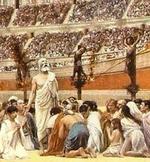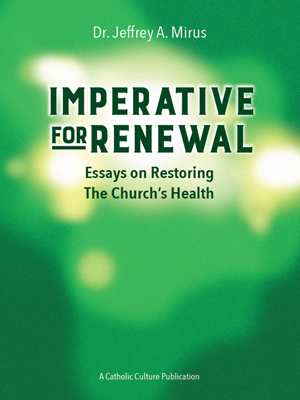The MOST Theological Collection: The Consciousness of Christ
"Chapter 2. Lack of Foreknowledge?"
Since, in the course of our analysis of form criticism (see Appendix 3), we answer the chief charges that the predictions of the passion and resurrection were forged by the Church, here we need only consider the special type of prediction contained in the words of Jesus about destroying and rebuilding the temple, and about the destruction of Jerusalem. Here Fr. Brown sees a problem:
Fr. Brown must think Jesus terribly stupid (as well as superstitious).2 Jesus must have been a deluded visionary to male such a prediction-if indeed it was a prediction-that the Temple would be destroyed, and that He would rebuild it! We say "deluded" since it did not come true. But, is it really necessary to suppose that Jesus really made that type of a prediction? Jn 2:21 said Jesus was speaking about "the temple of His body" which was to be destroyed by His death, but raised up in three days. Do we have to call that a Johannine "reinterpretation", which is a subtle way of saying that it was a falsification, since originally the saying, according to Brown, did not mean what John said it meant? I find no evidence to "force" me into accepting such a view. So I refuse to think of Jesus as a deluded visionary.
Note, moreover, how the saying as found in Jn. 2:19 uses the imperative form of the verb: "Destroy this temple, and in three days I will raise it up." Martin Luther has been much maligned, unjustly, for a famous line: "Sin mightily, but believe more mightily."3 It is erroneous to think Luther was really urging anyone to sin, and sin greatly. Rather, he was using a paratactic structure, one known in Greek, Latin and Hebrew. In parataxis one puts two clauses side by side. Gramatically, each seems independent, for there is no subordinating conjunction. Yet in sense, the normal listener recognizes that a conjunction is meant. So the real sense of Luther's words was: "Even if (or: although) you sin mightily, believe still more mightily." Now if we allow to Jesus what we extend to Luther, we will understand His saying to mean: "Even if you destroy this temple, I will raise it up in three days." Theoretically such a saying would be quite valid whether it referred to the Herodian temple at Jerusalem-Jesus could miraculously restore it in an instant-or to the temple of His body, as John understands it.
Further, Fr. Brown fails to notice that he is raising an objection against Jesus by depending on the precise wording used by false witnesses at Jesus' trial, and by those who meant to ridicule Him on the Cross. It is hardly common decency to make charges against Jesus based on wordings that come from those who intended to destroy Him by false testimony at an illegal trial or by ridicule as he was dying-crucified on Calvary. We hardly expected so low a blow.
Jesus' prophecy regarding the fall of Jerusalem is recorded in all three Synoptics. St. Matthew reports it in chapter 24, which opens with two questions by the disciples, first about the fall of Jerusalem, then about the return of Jesus at the end. It is likely that St. Matthew is following a multiple fulfillment pattern, i.e., that he wants the very same words to apply to both events, on the whole, even if not to absolutely every detail. Matthew does seem to use such a pattern elsewhere; e.g., in 2:15 he tells us that the Holy Family stayed in Egypt until the death of Herod, and then returned, "This was to fulfill what the Lord had spoken by the prophet, 'Out of Egypt have I called my son."' The allusion is to Hosea 11:1. But in the original setting, Hosea clearly meant Israel as the son whom God called out of Egypt in the Exodus.
Another multiple fulfillment pattern is probably found in Mt 1:22-23 which cites the prophecy of Is 7:14, "All this took place to fulfill what the Lord had spoken by the prophet: 'Behold, a virgin shall conceive and bear a son.'" The identity of that child has been widely debated. Yet Matthew, who surely was aware of divergent opinions, did not hesitate to say it was fulfilled in the conception of Jesus. Exegetes today commonly admit that the prophecy of the terrible moral disorder "in the last days" in 2 Tm 3:1-9 refers both to the entire Messianic period and also, more specifically, to the final days before the parousia.4 The same is said for the prophecy of 2 Tm 4:1-4.
There is, then, such a thing as a multiple fulfillment pattern. And we think that in chapter 24 Matthew is following that pattern, so that the signs described refer to both events, the fall of Jerusalem and the parousia. The following are the chief points: false Messiahs (Acts 5:36-37 tells us of such, Theudas and Judas of Galilee, who led revolts.5 Acts 21:38 reports still another, without giving his name); wars and rumors of wars (the Jewish revolt of 66, which Nero sent Vespasian to quell in 67 would be enough for this prediction, but there were also many other wars, especially in the year of the four emperors, 69 A.D.); pestilences, famines, and local earthquakes (Acts 11:28 tells of a famine in the time of Claudius, predicted by Agabus, Tacitus, Annals 16:13 says 65 A.D. was marled by storms, pestilence, hurricane, plague. Tacitus also reports other-earthquakes in the years 51, 53 and 62 A.D., in Annals 12:43; 12:58; 15:22); persecutions (there were many for the church before 70 A.D.); evil will reach its peak and the love of many will grow cold; the Gospel will be proclaimed in the whole world (it was proclaimed in most of the Mediterranean world, the world envisioned by the contemporaries of Jesus, by 70 A.D. Cf. Col 1:23; the abomination of desolation (perhaps referring to Jewish Zealots turning the temple into a fortress in 68 A.D., but it could also refer to Roman arms on the holy soil); false prophets working great signs; signs in nature (here we are dealing with apocalyptic language).
It is easy to see that many details in Jesus' prophecies on the fall of Jerusalem were fulfilled before 70 A.D. Presumably, if we are right about the multiple fulfillment pattern, similar phenomena will occur again before the parousia.
In their report of the same prophecies Mark and Luke show the multiple fulfillment pattern less clearly than does Matthew. It is because they wrote for Gentiles, for whom such a pattern would be hard to understand. Mark 13:1-37 mentions only one of the two questions asked by the disciples, the one about the fall of Jerusalem. Yet he does seem to have the parousia in mind, for in verses 24-25 he speaks of signs in the sun, the moon and stars, and verse 26 mentions the Son of Man coming on the clouds. Luke 21:5-36 also opens with the same question. He too mentions fearful things and portents in the sky in 21:11 and in 21:25-27, "there will be signs in sun and moon and stars...the powers of the heavens will be shaken.... And then they will see the Son of Man coming in a cloud with power and great glory."
Luke accordingly has much the same matter and pattern as Mark. But Luke adds a vivid detail in 21:20, "When you see Jerusalem surrounded by armies, then know that its desolation has come near." Some have said this is so vivid that it must have been faked after it happened. We reply to that charge in part 2 of the Appendix, pointing out that it merely reflects the general prejudice of form critics who gratuitously deny the very possibility of prophecies and miracles. Further, the charge here is equivalent to an accusation of dishonesty against Luke, another inadmissible ploy.
R. Brown, however, tries to eviscerate the prophecy by saying: "Its vocabulary is that of the prophetic description of the fall of Jerusalem to the Babylonians in the sixth century B.C. Like Jeremiah and Ezechiel, Jesus would be threatening disaster to a rebellious Jerusalem, and he would be using traditional language to do so."6 We have no objection to supposing Jesus deliberately borrowed language from the Old Testament. But that would not prove He had no knowledge of the future. Many an Old Testament prophet re-used the imagery of previous seers to express his own understanding of the future. How tendentious the critics are!
Brown adds still another charge, speaking of the prediction that not a stone would be left upon a stone: "If anyone would propose that this represented an exact fore-knowledge of what would happen in A.D. 70, he need simply be reminded that the gigantic blocks of the Temple foundation are still standing firmly one upon the other in Jerusalem."7
We find this assertion really astounding. First, the tendency to hyperbole in Hebrew (and other) literature is well known. Second, if Matthew and Luke were composed after 70 A.D., as so many scholars like to say, then both of these evangelists would have known the point Brown mentions. But then, would they not-if they were as dishonest as the critics claim they were-have glossed it over, or, more simply would they not have merely omitted the words? The fact that they did not means that, if they wrote after 70 A.D., they saw no problem, for they recognized as all natives would, a common Semitic exaggeration. The words implied total destruction, which did take place. If they wrote before 70 A.D., then we would still repeat our first point, that Semites commonly used picturesque exaggerations, so that the words, "not a stone upon a stone" would be fulfilled perfectly by the city's total destruction, even if some few rocks were still in place upon others in the ruined, desolate foundations.






